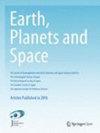利用最小二乘和长短期记忆混合模型提高极运动预测的精度
IF 2.5
3区 地球科学
引用次数: 0
摘要
摘要地球自转参数是实现天地参照系转换和高精度空间导航定位的重要参数。在erp中,极运动(PM)是分析和理解固体地球、大气、海洋和其他地球物理流体之间动态相互作用的关键参数。预测erp变化的传统方法严重依赖线性模型,如最小二乘(LS)和自回归(AR)模型(LS + AR)。然而,ERP的变化部分反映了地球系统的非线性效应,因此线性模型的预测精度并不总是最佳的。本文采用长短期记忆(LSTM)这一非线性神经网络来改进erp的预测。本研究采用LSTM模型和基于IERS EOP14C04时间序列的LS + LSTM混合方法进行极地运动预测实验。与公告A相比,LS + LSTM模型的PMX和PMY预测精度最高,分别达到33.7%和31.9%。实验结果表明,该混合模型在中长期(120 ~ 365天)极移预测中具有较好的效果。图形抽象本文章由计算机程序翻译,如有差异,请以英文原文为准。
Improving the accuracy of polar motion prediction using a hybrid least squares and long short-term memory model
Abstract Earth rotation parameters (ERPs) are essential for transforming between the celestial and terrestrial reference frames, and for high-precision space navigation and positioning. Among the ERPs, polar motion (PM) is a critical parameter for analyzing and understanding the dynamic interaction between the solid Earth, atmosphere, ocean, and other geophysical fluids. Traditional methods for predicting the change in ERPs rely heavily on linear models, such as the least squares (LS) and the autoregressive (AR) model (LS + AR). However, variations in ERP partly reflect non-linear effects in the Earth system, such that the predictive accuracy of linear models is not always optimal. In this paper, long short-term memory (LSTM), a non-linear neural network, is employed to improve the prediction of ERPs. Polar motion prediction experiments in this study are conducted using the LSTM model and a hybrid method LS + LSTM model based on the IERS EOP14C04 time series. Compared with Bulletin A, the PMX and PMY prediction accuracy can reach a maximum of 33.7% and 31.9%, respectively, with the LS + LSTM model. The experimental results show that the proposed hybrid model displays a better performance in mid- and long-term (120–365 days) prediction of polar motion. Graphical Abstract
求助全文
通过发布文献求助,成功后即可免费获取论文全文。
去求助
来源期刊

Earth, Planets and Space
地学天文-地球科学综合
CiteScore
5.80
自引率
16.70%
发文量
167
期刊介绍:
Earth, Planets and Space (EPS) covers scientific articles in Earth and Planetary Sciences, particularly geomagnetism, aeronomy, space science, seismology, volcanology, geodesy, and planetary science. EPS also welcomes articles in new and interdisciplinary subjects, including instrumentations. Only new and original contents will be accepted for publication.
 求助内容:
求助内容: 应助结果提醒方式:
应助结果提醒方式:


